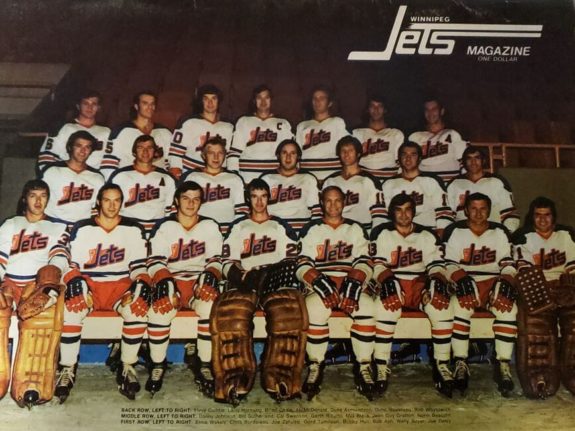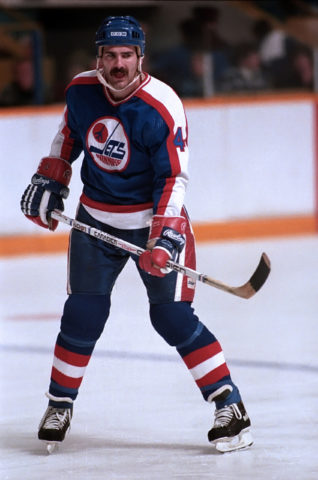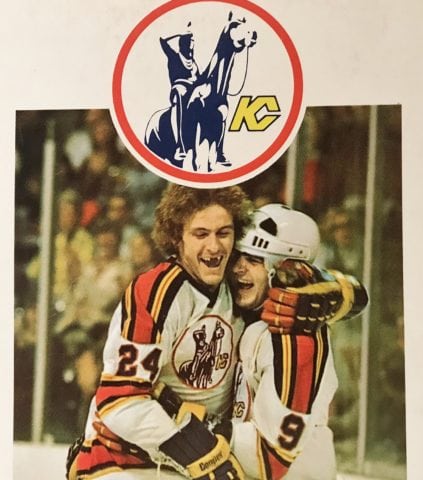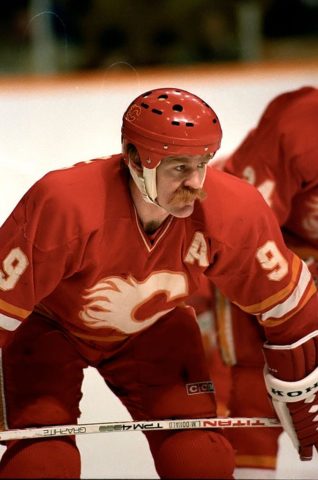On Oct. 17, 1980, the Winnipeg Jets scored an impressive 6-2 victory over the Chicago Black Hawks, bringing their record to 1-2-0 on the young season. Morris Lukowich scored a hat trick, Markus Mattson stopped 40 shots, and things were looking up for the Jets.
Little did they know they were about to enter into a hockey hell never experienced by any NHL team, before or since.
Related: Top 10 Highest Scoring NHL Games of the Modern Era
The Jets, it turned out, would not win another game for over two months. In the process, they established a new league record for consecutive games without a win – 30. As autumn gave way to the depths of a typically frigid Manitoba winter, the Jets lost 23 and tied seven in a valley of darkness that seemed to have no end.
Jets’ Second NHL Season
The 1980-81 season was Winnipeg’s second in the NHL. The franchise was born in 1972 as a charter member of the rival World Hockey Association. In 1979, after years of speculation, the WHA merged with the NHL, with four of its remaining six clubs moving into the older circuit: the Quebec Nordiques, Edmonton Oilers, New England (later Hartford) Whalers and the Jets. Winnipeg’s first NHL campaign was anything but easy, as they finished 20th in the 21-team league.

Their sophomore season wasn’t promising many clear skies, either, but with talented youngsters like defenseman Dave Babych, U.S. Olympic star Dave Christian, goalie Mattson and solid forwards like Lukowich and Willy Lindstrom, most expected the Jets to fly at least slightly higher than the previous year’s total of 51 points.
The season turned out to be more of a crash landing.
The ignominious winless streak began with a game that looked to be the beginning of a Jets winning streak. Two nights after the Chicago win, they were less than a minute away from a second straight victory, leading 4-2 over the Nordiques at home. But Quebec sniper Jacques Richard struck with 51 seconds left to make it 4-3. Later, with goalie Michel Plasse pulled in favor of an extra attacker, Jamie Hislop fired a desperate slapshot toward the Winnipeg net. The puck found its way through a maze of players and past Mattson. With no overtime or shootouts in the NHL at the time, the game ended in a 4-4 draw.
Blowing It Against the Bruins

With the winless streak sitting at four on Oct. 26, the Jets seemed poised to get off the schneid when they stormed back against the visiting Boston Bruins in the third period, erasing a 6-4 deficit with three goals to take a 7-6 lead into the final minutes. But a controversial goal by Wayne Cashman at 16:16, in which it appeared he may have batted the puck into the net with his hand, was allowed to stand by referee Wally Harris and Winnipeg was denied the W.
When it came to leads, holding on proved harder for the Jets than for a rodeo rider on a bucking bronco. On Halloween night versus Pittsburgh, the Winnipeg Arena proved to be scarier than any haunted house for the Jets as they blew a 5-3 lead by giving up three unanswered Penguin goals in the third period.
Two nights later, leading 4-2 against the hardly imposing Washington Capitals with only a minute and a half to play, the Jets surrendered two goals – including Jean Pronovost’s tying marker with just five ticks left on the clock – to once again stay out of the win column. They followed that embarrassment by blowing a comfortable 5-2 lead against the Calgary Flames, letting in three goals in less than four minutes and settling for a 5-5 tie.
Related: Old School NHL Jerseys – Gone But Not Forgotten
The losses and ties continued to mount throughout November. The Jets endured a particularly horrific three-game stretch in mid-November, losing games to Montreal, Vancouver and Los Angeles by a combined score of 18-4. Coach Tom McVie tried to keep the atmosphere as positive as possible for his young troops, but even he was running out of ideas. “It’s tough to tell guys to keep going when they keep getting kicked in the head.” (from ‘Is Sophomore Jinx Affecting NHL?’ Vancouver Sun, November 18, 1980)
Jets Get Desperate For a Win
Some players believed a bit of external motivation might get them out of their funk of futility. Left-winger Danny Geoffrion issued a desperate plea to Winnipeg fans to get more vocal at the games. “This is an SOS. Help us out of this. We need you. Make us play like we can.” (from “Shake-Up in Store to End Jets’ Tailspin,” Regina Leader-Post, November 28, 1980)

Defenseman Barry Long was more terse. “Maybe what we need is a swift kick in the ass.”
Regardless of the many ideas floated by players, the media, coaches and fans, nothing worked. November closed with an uninspired 4-1 loss to the Flames at home. The Jets had gone 0-for-the-month (0-10-5). The Calgary loss marked the beginning of a losing streak within the winless streak. When it hit five (bringing the winless skid to 25) with an 8-5 trouncing at the hands of the Hartford Whalers, general manager John Ferguson pulled the plug on McVie.
“We’ve been concerned about the fact that we were not winning,” said Ferguson in perhaps the biggest understatement in hockey history. (from “Ferguson’s Axe Falls on Old Pal,” Vancouver Sun, December 12, 1980)
“We just couldn’t get the monkey off our back to win a hockey game,” said McVie. “It got progressively worse. When you keep losing, you start inventing ways to lose.”
McVie’s replacement was assistant coach Bill Sutherland. “Tom’s a great disciplinarian and I’m softer and easy-going,” he said. “It might just have an effect on the hockey club.”
Well, not immediately.
Setting the Streak Record
A 4-3 loss to Minnesota in Sutherland’s debut brought the Jets to the brink of tying the longest winless streak in NHL history – 27, set by the 1975-76 Kansas City Scouts. To avoid such a fate, they would have to beat the defending Stanley Cup Champion New York Islanders, and with Mike Bossy notching a hat trick on the night, it just wasn’t going to happen. The Jets fell 5-4, and set a new record two nights later when they were hammered by the same Islanders in New York to the tune of 6-2.
“Maybe some day we can laugh about it – when some other team goes past it,” said Sutherland. “It’s not a good record to have, but I’m proud of them. They did not give up. They play as hard as they can.” (from “How Do You Spell Grief? J-E-T-S,” Vancouver Sun, December 17, 1980)

One week and two more losses later, the streak stood at an even 30 as the Colorado Rockies came to town two days before Christmas. The Jets had not faced the 11-16-6 Rockies yet, and if ever there was a golden opportunity to break the streak, this was it. The bumbling Rockies had won only once in their past eight games.
Winnipeg jumped out to a 3-0 lead, but in typical 1980-81 Jet fashion, they left the door wide open for their opponents to get back in the game. Two Colorado markers in the third tied the game at four. With just over two minutes left, Lanny McDonald beat Jets goalie Pierre Hamel – but not the post – and the game stayed tied.
Maybe, just maybe, things were finally going to go Winnipeg’s way.
Sure enough, a few seconds later, Willy Lindstrom beat Al Smith with a 15-footer to put the Jets ahead 5-4. For once, they held on until the final buzzer sounded. The streak was, at last, over.
“You should have seen the dressing room when they came in – it was like they had won the Stanley Cup,” said an elated Sutherland. (from “Early Present For Jets,” Nanaimo Daily Free Press, December 24, 1980)
“It was a Christmas present for our fans,” added Geoffrion.
The Streak’s Silver Lining
The rest of the season proved to be only slightly less painful for the Jets. They won only seven more times, finishing with a record of 9-57-4. To his credit, GM Ferguson never succumbed to the temptation to trade any of his promising youngsters for an aging veteran or two for the sole purpose of ending the streak.
You may also like:
- 3 Winnipeg Jets Who Could Earn a Roster Spot in 2024-25
- 3 Jets Who Will Be Under the Microscope in 2024-25
- Best & Worst Trades in Winnipeg Jets’ History
- Manitoba Moose Gain Flexibility with Jets’ Signings
- Top Contenders for 2025 Calder Trophy
And there was a major silver lining to the dark cloud that was the 1980-81 Winnipeg Jets season: Finishing last gave them the first overall pick in the 1981 draft, with which they selected a young scoring sensation who would become the face of the franchise for the next 10 years – future Hall of Famer Dale Hawerchuk.
